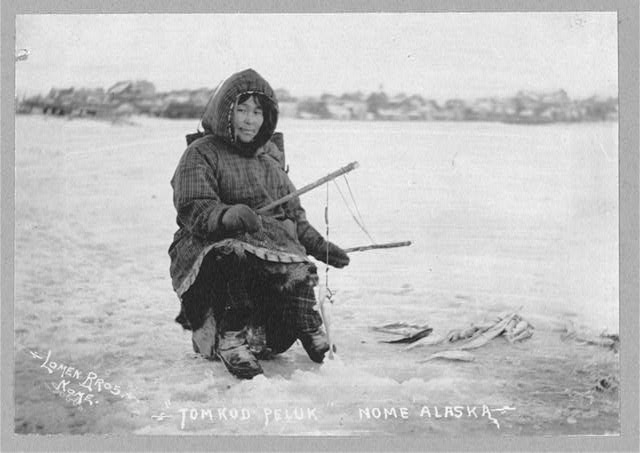Teach This Poem, though developed with a classroom in mind, can be easily adapted for remote learning, hybrid learning models, or in-person classes. Please see our suggestions for how to adapt this lesson for remote or blended learning. We have also noted suggestions when applicable and will continue to add to these suggestions online.

Look closely at Lomen Bros' photograph of the person ice fishing.
The following activities and questions are designed to help your students use their noticing skills to move through the poem and develop their thinking about its meaning with confidence, using what they’ve noticed as evidence for their interpretations. Read more about the framework upon which these activities are based.
-
Warm-up: Look closely at the image of the person ice fishing. What stands out to you in the image? Look again? What else do you notice? What type of fish might this person catch?
-
Before Reading the Poem: Watch this short video about Narwhals. What stands out to you in this video? What facts did you learn?
-
Reading the Poem: Now, read the poem “Narwhals Are Real” by Gloria Muñoz silently. What do you notice about the poem? Annotate for any words or phrases that stand out to you or any questions you might have.
-
Listening to the Poem (enlist two volunteers to read the poem aloud, in English and Spanish): Listen as the poem is read aloud twice, and write down any additional words and phrases that stand out to you. Note what differences you hear in the two languages.
-
Small-group Discussion: Share what you noticed in the poem with a small group of students. Based on the details you just shared with your small group and the resources from the beginning of class, what connections, if any, can you make between the video, the image and the poem?
-
Whole-class Discussion: What is the significance of the title? How might the poem be different without it? Is there anything or anyone that you feel an affinity for, like the speaker seems to feel an affinity for Narwhals?
-
Extension for Grades 7-8: How might Narwhals feel about their “cult following?” Write a response from the point of view of a Narwhal. What might the Narwhal want to say? Your response can be a speech, a letter, a poem, or anything that you envision. If you can speak more than one language, write your response in both languages, and share what the process of translation was like.
-
Extension for Grades 9-12: In honor of National Translation Month (September) and National Hispanic Heritage Month (September 15-October 15), continue reading poems. Choose one Hispanic poet to read and learn more about. Participate in a class reading where you share your favorite poem by your chosen poet as well as information about the poet’s life and accomplishments.
In her introductory lesson plan, Queens teacher Carol McCarthy calls upon her students to investigate poetry through the lens of their individual cultural backgrounds. Students translate the work of poets from their native country or ethnic heritage, then write and translate their own poems. Students probe poetry in translation in other lessons as well, including "Translating Poets of the Holocaust Era," "Haiku," "Women in Poetry," and a comparative lesson focusing on two translations of Beowulf. Against this backdrop, Carol employs a series of classroom learning activities and Internet research that helps each student to find their place in a poetic tradition.
This week’s poetic term is anthropomorphism, which means the attribution of human traits, actions, or emotions to an animal, object, or other nonhuman figure. Read more.
